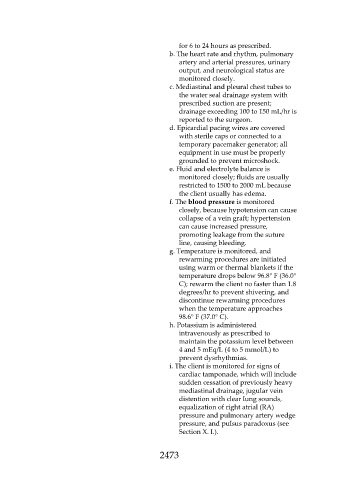Page 2473 - Saunders Comprehensive Review For NCLEX-RN
P. 2473
for 6 to 24 hours as prescribed.
b. The heart rate and rhythm, pulmonary
artery and arterial pressures, urinary
output, and neurological status are
monitored closely.
c. Mediastinal and pleural chest tubes to
the water seal drainage system with
prescribed suction are present;
drainage exceeding 100 to 150 mL/hr is
reported to the surgeon.
d. Epicardial pacing wires are covered
with sterile caps or connected to a
temporary pacemaker generator; all
equipment in use must be properly
grounded to prevent microshock.
e. Fluid and electrolyte balance is
monitored closely; fluids are usually
restricted to 1500 to 2000 mL because
the client usually has edema.
f. The blood pressure is monitored
closely, because hypotension can cause
collapse of a vein graft; hypertension
can cause increased pressure,
promoting leakage from the suture
line, causing bleeding.
g. Temperature is monitored, and
rewarming procedures are initiated
using warm or thermal blankets if the
temperature drops below 96.8° F (36.0°
C); rewarm the client no faster than 1.8
degrees/hr to prevent shivering, and
discontinue rewarming procedures
when the temperature approaches
98.6° F (37.0° C).
h. Potassium is administered
intravenously as prescribed to
maintain the potassium level between
4 and 5 mEq/L (4 to 5 mmol/L) to
prevent dysrhythmias.
i. The client is monitored for signs of
cardiac tamponade, which will include
sudden cessation of previously heavy
mediastinal drainage, jugular vein
distention with clear lung sounds,
equalization of right atrial (RA)
pressure and pulmonary artery wedge
pressure, and pulsus paradoxus (see
Section X. I.).
2473

